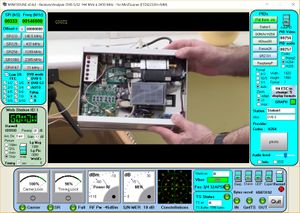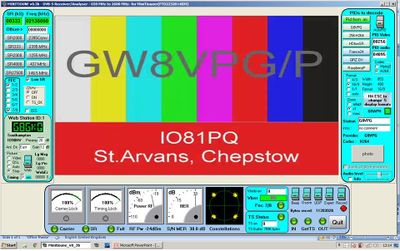Difference between revisions of "MiniTioune"
| Line 37: | Line 37: | ||
=== Receive upconverters === | === Receive upconverters === | ||
| + | |||
| + | The Serit tuner currently on sale in the shop cover 144 - 2450 MHz and does not require any external frequency converters. | ||
The original Sharp and Eardatek tuner components (also called NIM) used in MiniTiouner cover a maximum of 650 to 2600 MHz. | The original Sharp and Eardatek tuner components (also called NIM) used in MiniTiouner cover a maximum of 650 to 2600 MHz. | ||
Whilst this is fine for the 23cms (1.3 GHz) and 13cms (2.3 GHz) amateur bands it does not provide coverage of 146 (2mts) and 437 MHz (70cms) where the majority of ATV operation takes place. Therefore we need to use an upconverter in front of the tuner which converts 146 MHz and 437 MHz up to an L band frequency that the MiniTiouner will receive. | Whilst this is fine for the 23cms (1.3 GHz) and 13cms (2.3 GHz) amateur bands it does not provide coverage of 146 (2mts) and 437 MHz (70cms) where the majority of ATV operation takes place. Therefore we need to use an upconverter in front of the tuner which converts 146 MHz and 437 MHz up to an L band frequency that the MiniTiouner will receive. | ||
| − | |||
| − | |||
[[Receiver upconverters|A separate section on the wiki gives details of these upconverters.]] | [[Receiver upconverters|A separate section on the wiki gives details of these upconverters.]] | ||
Revision as of 16:48, 4 February 2019
The MiniTioune receiver project, developed by Jean-Pierre F6DZP, consists of the home constructed MiniTiouner hardware which interfaces via a standard USB 2.0 port to a Windows PC running the MiniTioune software.
 Hardware <------------> Windows Software
Hardware <------------> Windows Software 
It will receive DVB-S QPSK and DVB-S2 QPSK, 8PSK, 16APSK, 32 APSK from broadcast and amateur TV transmissions with symbol rates (SR) from 30 Msymbols down to 120 Ksymbols per second.
It can be used to receive satellite broadcasts, "normal" DATV signals and is the ONLY system capable of receiving Reduced Bandwidth (RB-TV) transmissions.
Definitions
The following terms should be used when describing this project - note "MiniTiouner" is the French project name but maybe pronounced "Minituner" in English.
- MiniTioune = PC software
- MiniTiouner = The complete project hardware with USB interface - this can be prefixed with the type of tuner eg "Sharp Minitiouner"
Hardware overview
The MiniTiouner hardware has no surface mount components and requires medium level constructional skills. BATC sells the hard to get components and the rest are available from normal suppliers.
Full details of the current version 2 MiniTiouner hardware and build information are available here - new builders should start on this page.
Details of the previous hardware versions are available here.
Software
Full details of the MiniTioune software which is free to download and designed to be used with the MiniTiouner hardware are available here MiniTioune software.
Band Pass filters
There is a whole section of the wiki dedicated to this most important part of your system - take a look at the pictures on the top of this page to see why you must use filters before your MiniTiouner!
Receive upconverters
The Serit tuner currently on sale in the shop cover 144 - 2450 MHz and does not require any external frequency converters.
The original Sharp and Eardatek tuner components (also called NIM) used in MiniTiouner cover a maximum of 650 to 2600 MHz.
Whilst this is fine for the 23cms (1.3 GHz) and 13cms (2.3 GHz) amateur bands it does not provide coverage of 146 (2mts) and 437 MHz (70cms) where the majority of ATV operation takes place. Therefore we need to use an upconverter in front of the tuner which converts 146 MHz and 437 MHz up to an L band frequency that the MiniTiouner will receive.
A separate section on the wiki gives details of these upconverters.
